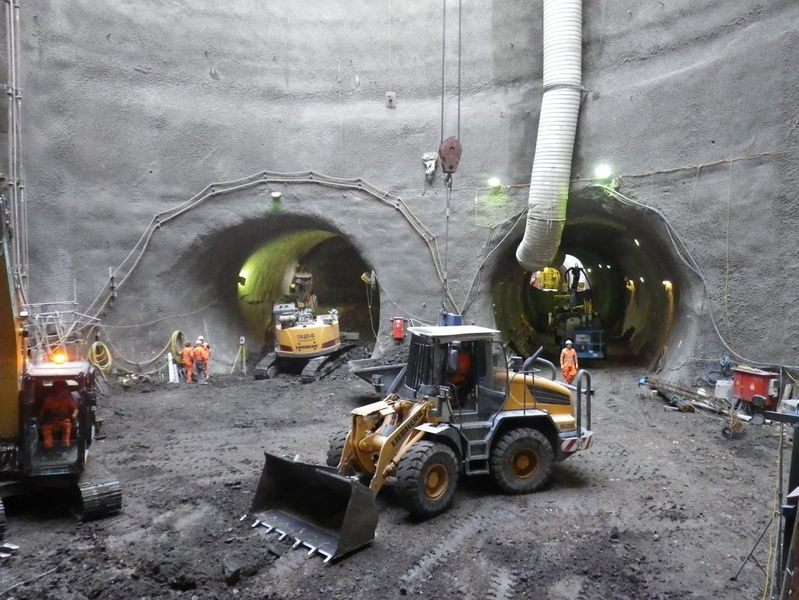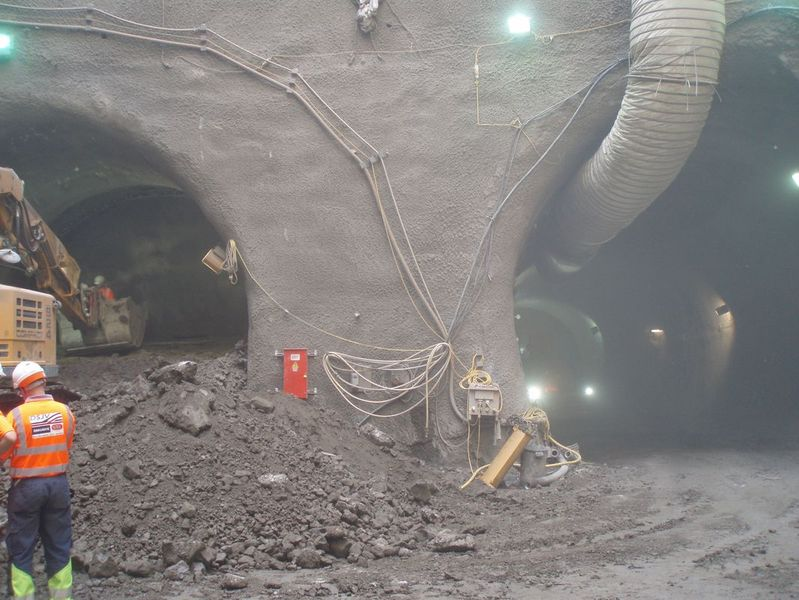Categories
You are here
Sprayed Concrete Lining (SCL) Works at Crossrail (CRL) - C305: Eastern Running Tunnels, London, UK
Project Overview
Crossrail is currently Europe's largest infrastructure project which will deliver a high frequency, high capacity service to 37 stations linking Maidenhead and Heathrow in the west, to Shenfield and Abbey Wood in the east of England.
After completion, CRL's central section will run via 21 km twin-bore tunnels from Royal Oak Portal to Victoria Dock Portal under central London including 7 new underground stations at Paddington, Tottenham Court Road, Bond Street, Farringdon, Liverpool Street, Whitechapel and Canary Wharf.
Contract C305 is the biggest design-bid-build construction contract of the CRL project and was awarded to the Spanish-Irish Dragados-Sisk joint venture (DSJV). The contract includes the eastern running tunnels of CRL's central section with launch shafts and SCL launch adits for TBMs at Limmo Peninsula, SCL caverns and launch adits for TBMs at Stepney Green and 10 SCL cross passages between the running tunnels with lengths up to 30 metres. Works started in 2011 with an Optimised Contractor Involvement (OCI) period followed by pre-construction and construction works that started in 2012.
At Limmo Peninsula site two 40 m deep and 30 m diameter shafts where built first. One shaft was sunk by using diaphragm walls the second, so called Auxiliary shaft was built utilising the SCL construction method. At the bottom of each shaft two 15 m long and 8 m wide SCL launch adits were excavated and two 55 m long and 8 m wide SCL tunnels constructed in order to connect both shafts. All SCL works at Limmo Peninsula followed a Top Heading, Bench and Invert excavation sequence and were carried out in London Clay.
To start tunnelling works at Stepney Green site a rectangular 40 m deep diaphragm wall shaft has been built in a dense urban area with a school and city farm adjacent to the boundaries of the limited construction site. At the shaft bottom two 30 m long and up to 10 m wide SCL launch adits will be constructed to the west in a Top Heading, Bench and Invert excavation sequence.Out of the shaft and towards the east two, up to 14 m high and 18 m wide, SCL caverns will be constructed with single sidedrift and double sidedrift cross sections. The eastbound tunnels at Stepney Green site are all in London Clay, in the westbound tunnels the top section of the tunnels is in London Clay as well but in the section below the tunnel axis the Lambeth Group with sand units will be encountered.
The Cross Passages are spread along the length of the C305 running tunnels and are up to 30 m long and between 4.3 m and 6.2 m wide. They will be excavated concurrently with the TBM advance of the running tunnels and require special logistical arrangements. Geological locations of the cross passages vary from London Clay to Lambeth Group and Thanet Sands.
All C305 SCL works consist of a SFR sprayed concrete primary lining, sprayed-on or sheet membrane waterproofing system and either cast in situ or sprayed concrete secondary lining.
DSP Engineering Support Services
- Dr. Sauer & Partners Ltd. (DSP) was involved in the Optimised Contractor Involvement (OCI) period and supported the DSJV with the preparation of OCI proposals for SCL works at Limmo Peninsula, Stepney Green and Cross Passages.
- DSP continued engineering support services during the pre-construction phase of the C305 contract. Services included value engineering proposals and SCL document preparation such as SCL Management Plan, SCL Action Plan,Inspection and Test Plans and SCL Method Statements for the Limmo Peninsula, Stepney Green and Cross Passage sites.
- During the construction phase at Limmo Peninsula DSP's engineering support service extended into a design for the 30 m dia. SCL Auxiliary shaft and included development of various details like temporary headwalls to facilitate the TBM launch from the SCL launch adits.
DSP Site Supervision Services
DSP provided site supervision services during the construction of the SCL Auxiliary shaft and SCL tunnels at Limmo Peninsula site. A team of Senior SCL Engineers and SCL Engineers was responsible for analysing monitoring data and documenting the project's progress, including daily site inspection, ground conditions encountered, monitoring data, and installation of support elements.The DSP Senior SCL Engineer chaired a daily RES meeting and issued the RESS.
More News...
Crossrail Website
SCL to create Crossrail junction caverns (published on September 2012 on tunneltalk.com)

Figure 1: Limmo Plan View

Figure 2: Limmo Auxiliary Shaft Model

Figure 3: Limmo Auxiliary Shaft Bottom

Figure 4: SCL Tunnel excavation from Auxiliary shaft to Main shaft

Figure 5: SCL Works in Limmo Auxiliary Shaft

Figure 6: Westbound Excavation Face at Limmo Peninsula

Figure 7: Teardrop Shape in Top Heading, Bench, Invert Excavation Sequence

Figure 8: Stepney Green Plan View